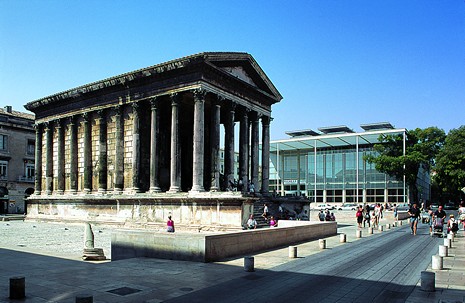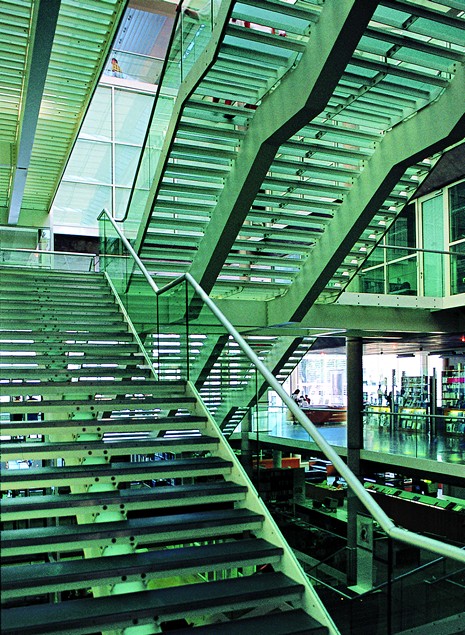Description
The unusual urban context, a square directly opposite the Roman temple on a podium known as the Maison Carrée in the heart of Nîmes in southern France, was a decisive influence on Norman Foster’s design, which he revised several times. In order to accommodate the enormous volume without disturbing the proportions of its surroundings, half of the nine-storey building – which in addition to an art museum also contains a library, a mediatheque, and other cultural facilities – was placed underground. The volume visible above a stone plinth, a transparent, modular, structured prism of light construction, turns its narrow side to face the ancient temple. The gracefully articulated, dazzling white steel scaffolding of the lamella canopy behind which the actual building retreats in asymmetric gradation, paraphrases in a way as unmistakable as it is discreet the classical architecture of articulated building elements, whose structural proportions Foster’s façade allusively picks up. The main entrance shifted to the corner and its counterpart, diagonally opposite on the rear façade, emphasize the function of the Carrée d’Art as an urban joint on an important urban connection axis.
The interior is laid out around a glass-roofed central courtyard that extends all the way to the library rooms on the lower storey and supplies the entire building with light. The individual floors are arranged like galleries around this atrium, in which a broad stairway of semi-transparent greenish glass not only collects and distributes the stream of visitors, but also effectively fractures and modulates the incidence of light. From outside, the light is filtered through metal Venetian blinds, whose horizontal lines form an important design element. Glazed roofs with two fields of lamella allow the regulation of light intensity and light incidence in the high-ceiling exhibition rooms on the top floor. It is here too that we find the observation platform under the filigree canopy, from which one can see the classical temple set out on display like a costly jewel – in a way, the goal of the central stairway.
Techniques et Architecture 357/1984, pp. 10-15 (A. Pélissier) • The Architectural Review 1059/1985, pp. 31-43 (Jonathan Glancey) • François Chaslin/Frédérique Hervet/Armelle Lavalou, Norman Foster, Stuttgart, 1987, pp. 114-123 • architektur aktuell 159-160/1993, pp. 38-42 • Baumeister 8/1993, pp. 40-49 (Jonathan Glancey) • Bauwelt 19/1993, pp. 993-1000 (Sebastian Redecke) • Deutsche Bauzeitschrift 9/1993, pp. 1419-1423 (M. Helle) • Räume für Kunst, exhibition catalogue, Graz, 1993, pp. 24-25 (Josep M. Montaner) • James Steele (ed.), Museum Builders, Berlin, 1994, pp. 58-63 • Werk, Bauen und Wohnen 1-2/1994, pp. 12-15 • Vittorio Magnago Lampugnani/Angeli Sachs (eds.), Museums for a New Millennium, Munich/London/New York, 1999, pp. 34-41 (Kenneth Powell)
Drawings
Ground floor
Third floor, mediatheque
Fourth floor, exhibition areas
Cross section
Longitudinal section with surroundings
Study of the proportional relations between the Maison Carrée and Carré d’Art
Photos

View of the Maison Carrée and the Carré d’Art

View of the central staircase
Originally published in: Paul von Naredi-Rainer, Museum Buildings: A Design Manual, Birkhäuser, 2004.